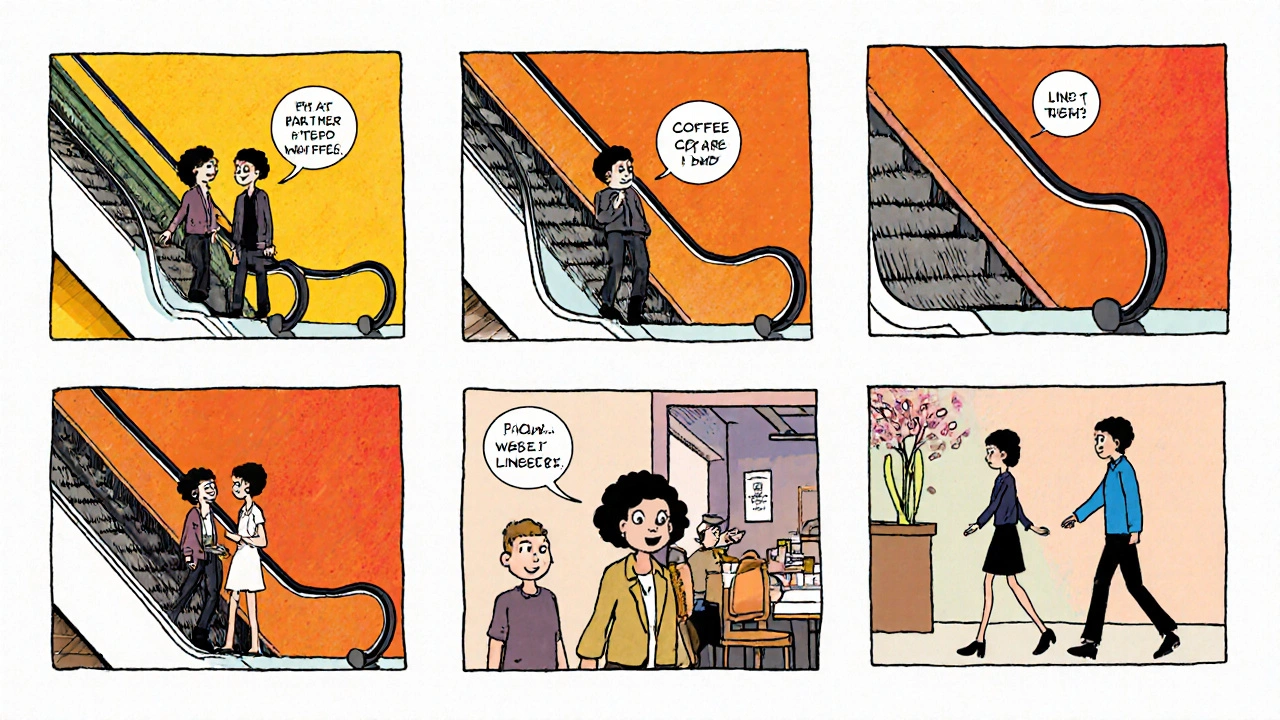Ever wondered who should step off the escalator first on a date? That tiny moment actually folds into a bigger conversation about respect, expectation, and comfort. Below we’ll unpack the escalator rule, see how it fits into modern dating etiquette, and give you a cheat sheet so you never feel stuck on a moving stairway again.
What the Escalator Rule Actually Is
Escalator Rule is a dating etiquette guideline that suggests the person who initiated the date (or the person who feels more comfortable leading) should exit the escalator first, signaling a courteous end to the outing. It’s less about who pays and more about who takes the cue to end the encounter gracefully. The rule emerged from the broader push for clear, non‑verbal signals that help both parties leave on a positive note.
Where Did the Rule Come From?
- Dating coaches in the early 2010s started using escalators as a low‑stakes testing ground for comfort levels.
- Social psychologists note that small physical gestures-like who steps off first-can convey dominance or deference without words.
- Urban environments (think Manhattan, London, Detroit) where escalators are common in malls and subway stations gave the rule practical visibility.
By the time swipe‑right culture took off, the escalator rule slipped onto blog posts and YouTube tutorials as a quick litmus test for mutual interest.
How to Apply the Rule on a First Date
- Identify who initiated the meetup. If you asked, you own the “lead” role.
- Gauge the vibe. If your date seems eager to keep talking, you can linger a bit longer on the moving stairs.
- When you reach the top, pause. Make eye contact, smile, and say something casual like, “Let’s grab a coffee before we part.”
- If the conversation naturally ends, step off first. This shows confidence and respect for their time.
- If they step off first, follow suit politely. No need to argue about who’s “right.”
These steps keep the moment low‑pressure, letting both people leave with a clear sense of closure.

Common Variations and Edge Cases
Not every date follows the same script. Below are a few scenarios where the rule bends:
- Group outings: The host or the person who organized the gathering usually steps off first.
- Long‑distance video dates: The “virtual escalator” translates to ending the call with a clear goodbye cue.
- Power dynamics: If one party feels uncomfortable, they can politely ask to be the one to step off.
- Accessibility considerations: If a partner uses a wheelchair or has mobility challenges, the rule defers to their needs.
Escalator Rule vs. Other Dating Etiquette Rules
| Rule | Primary Focus | Typical Initiator | Common Misstep |
|---|---|---|---|
| Escalator Rule | Ending a date gracefully | Person who led the outing | Both linger too long |
| Pay‑the‑Bill Rule | Financial responsibility | Person who invited | Assuming gender‑based split |
| First‑Move Rule | Initiating contact | Anyone interested | Over‑eagerness or hesitation |
| Texting Etiquette | Communication timing | Both parties | Ghosting or double‑ texting |
Understanding these differences helps you avoid mixing signals-like paying the bill but staying on the escalator too long, which can send mixed messages.
Pros and Cons of Using the Escalator Rule
- Pros
- Provides a clear, non‑verbal cue for ending the date.
- Reduces awkward small talk after the venue.
- Shows leadership without being overbearing.
- Cons
- Can feel outdated if both parties expect a more collaborative sign‑off.
- May clash with cultural norms where the opposite gender traditionally steps off first.
- Risk of misinterpretation if the other person thinks you’re rushing them away.

Cheat Sheet: Quick Reference for the Escalator Rule
- Who initiated the date? You step off first.
- Did the conversation naturally end? Exit first, but smile.
- Is the other person uncomfortable? Offer to let them lead instead.
- Special circumstances (group, accessibility, virtual)? Adjust accordingly.
Common Mistakes and How to Fix Them
Even seasoned daters slip up. Here are the top blunders and quick fixes:
- Staying on the escalator too long - If you sense the date is winding down, step off. A brief “It was great meeting you” works.
- Assuming the other person will read your mind - A friendly verbal cue like “I should head out” clears any doubt.
- Ignoring power dynamics - If the other person seems hesitant, ask, “Do you want to stay a bit longer?”
- Forgetting accessibility - Offer assistance if you see a mobility aid, and let them dictate the pace.
Frequently Asked Questions
Is the escalator rule still relevant in 2025?
Yes. While many couples now choose collaborative cues, the rule still offers a simple, low‑stakes way to signal the end of a date without words.
What if my date wants to stay longer but I’m ready to leave?
A polite "I had a great time, but I have an early morning" acknowledges their interest while honoring your schedule.
Does the rule apply to non‑escalator exits, like elevators or stairs?
The principle extends to any shared exit point. The lead person can still step off first as a polite cue.
How does the escalator rule intersect with the pay‑the‑bill rule?
They cover different moments: the pay‑the‑bill rule handles financial closure, while the escalator rule deals with physical departure. Using both can create a seamless end‑to‑end experience.
Can I ignore the rule if I feel uncomfortable?
Absolutely. Etiquette guidelines are flexible. Communicate your comfort level directly-honesty beats any unwritten rule.
Mastering the escalator rule isn’t about rigid scripts; it’s about reading signals, showing respect, and making a smooth exit. Next time you’re on a moving staircase, you’ll know exactly what to do.


Written by Eldridge Fairweather
View all posts by: Eldridge Fairweather